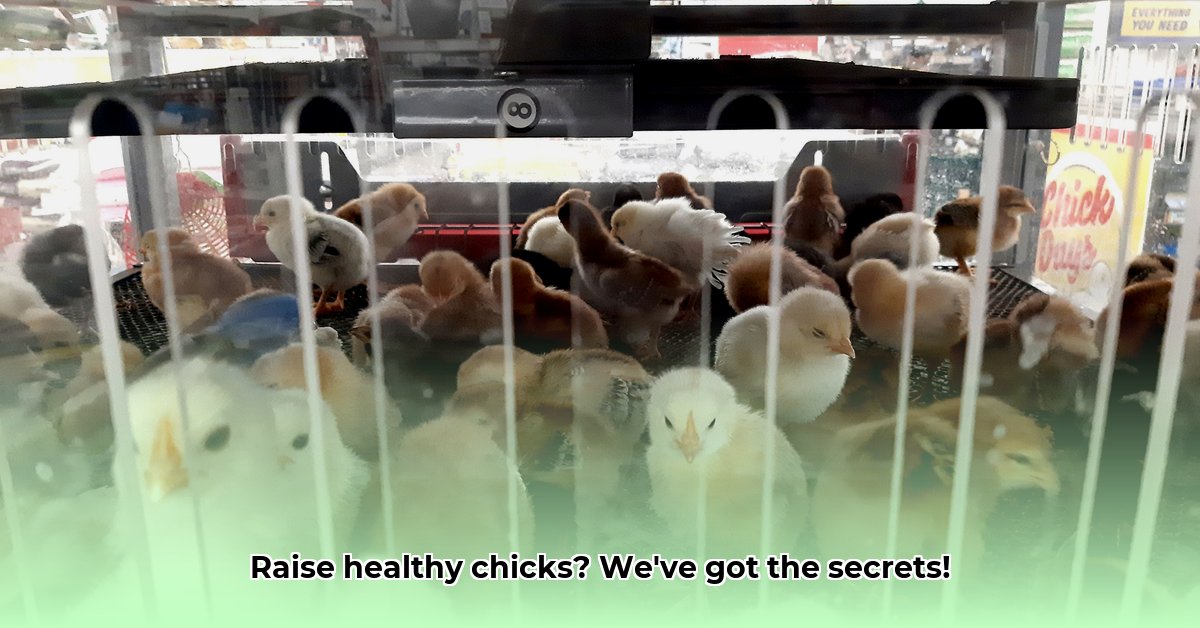
How Old Are the Chicks at Tractor Supply?
When you purchase chicks from Tractor Supply, they're typically between one and four days old – essentially newborns! Understanding their age is crucial for providing appropriate care and ensuring their healthy development. This knowledge guides your approach to brooding, feeding, and overall chick management. For more advanced housing options, check out this guide on building a chicken tractor.
Getting Your Chick Nursery Ready: Building a Cozy Home
Before your chicks arrive, prepare their brooder – a safe, warm enclosure. This will be their temporary home until they're larger.
Essential Supplies:
- Sturdy box (large enough for the number of chicks, allowing for growth)
- Heat lamp (crucial for warmth; initially set to 95°F (35°C))
- Soft bedding (wood shavings are ideal; avoid anything potentially harmful)
- Chick starter feed (specially formulated for their nutritional needs)
- Shallow water dishes (to prevent drowning)
Step-by-Step Brooder Setup:
- Build Your Brooder: Choose a sturdy box or container, ensuring ample space to prevent overcrowding and stress.
- Install the Heat Lamp: Position the heat lamp to maintain the initial temperature of 95°F (35°C). Monitor closely and adjust as needed.
- Add Comfy Bedding: Use absorbent, clean bedding like wood shavings. Regularly change bedding to maintain cleanliness.
- Secure the Brooder: Ensure the brooder is escape-proof to keep your chicks safe. Close off any gaps or holes.
- Provide Food and Water: Fill shallow water dishes and provide chick starter feed. Keep food and water fresh and clean at all times.
Those First Few Weeks: Chick Intensive Care
The first few weeks are critical for your chicks' survival and healthy growth. Careful monitoring and attentive care are paramount during this intensive care period.
Week 1-4: The Tiny Tot Stage: Maintain the 95°F (35°C) temperature, monitoring the chicks' behavior. Are they huddled closely (too cold)? Scattered widely (too hot)? Adjust the heat lamp accordingly. Provide fresh food and water multiple times daily. Clean up droppings regularly. Did you know that consistent cleaning reduces disease risk by up to 80%?
Weeks 4-8: Growing Up Fast: Your chicks are growing rapidly! Gradually reduce the heat lamp's intensity. Transition to grower feed, formulated for their increased nutritional needs. At this stage, increasing activity levels and exploring their environment are positive signs of healthy development.
Beyond 8 Weeks: Young Adults: Provide more space in a coop designed for older birds. Transition to pullet feed (if raising hens) to prepare them for egg-laying. Remember to consider the breed-specific growth rates; some breeds mature faster than others.
Breed Matters: Growth Varies
Different chicken breeds mature at different rates. Consult breed-specific guides or your local feed store for guidance tailored to your chosen breeds. This ensures you provide appropriate care for their unique developmental stages.
Potential Problems: Being Prepared
Anticipating potential problems allows for proactive measures to ensure your chicks' well-being.
| Potential Problem | Likelihood | Severity | Prevention/Solution |
|---|---|---|---|
| Chick deaths | Moderate | High | Proper brooding, good nutrition, regular cleaning, prompt veterinary care if needed |
| Diseases | Low | Very High | Vaccination (if needed, consult your vet), good hygiene, quarantine new birds |
| Predators | Moderate | High | Secure coop and run, use predator deterrents (netting or chicken wire) |
| Temperature issues | Moderate | High | Careful heat lamp management, gradual temperature adjustments, monitor weather closely |
| Nutritional deficiencies | Moderate | Moderate | Balanced feed, fresh water, watch for lethargy, poor appetite |
How to Prevent Diseases in Tractor Supply Chicks
Proactive disease prevention is crucial for a thriving flock. Here's a multi-pronged approach:
Choosing Healthy Chicks: The First Line of Defense
Carefully inspect each chick for bright eyes, clean vents, and active behavior. Avoid lethargic or unwell-appearing chicks. Selecting healthy chicks significantly reduces the initial risk of disease introduction.
Setting Up a Safe and Clean Environment
Maintain a clean brooder by regularly changing bedding and removing droppings. Disinfect the brooder completely before introducing your chicks. Consistent cleanliness minimizes the buildup of harmful bacteria and viruses.
Nutrition and Hydration: Fueling Immunity
Provide high-quality chick starter feed and access to fresh, clean water. Consider adding probiotics to support gut health and immunity. Proper nutrition is fundamental for their immune system development.
Biosecurity Measures: Keeping the Bad Guys Out
Practice good hygiene by washing hands before and after handling chicks. Avoid introducing outside birds or animals to minimize disease transmission. Biosecurity protocols greatly reduce the introduction of pathogens.
Monitoring for Signs of Illness: Catching Problems Early
Monitor your chicks daily for signs of illness (lethargy, ruffled feathers, diarrhea, poor appetite). Isolate sick chicks to prevent outbreaks. Early detection is paramount for successful treatment and prevents widespread illness.
Vet Care: When to Seek Professional Help
Contact your veterinarian if you observe any unusual symptoms. Prompt veterinary care is crucial for managing illness effectively. Consulting a veterinarian ensures your chicks receive appropriate and timely treatment.
Considering Breed-Specific Predispositions
Research the breed-specific health predispositions to provide targeted care and minimize potential problems. Understanding potential breed-specific health concerns allows for proactive management strategies.